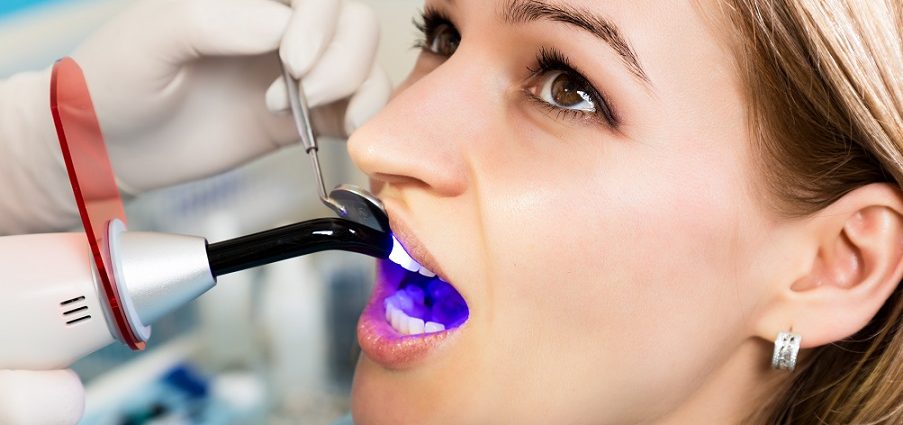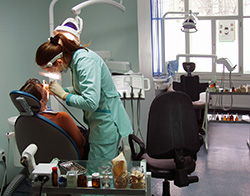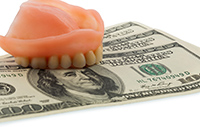Bonding vs Crowns

No matter how well you take care of your teeth, chips happen. Tooth chipping is an issue that many people deal with at one time or another in their life. Fortunately, repairing a chipped tooth can be relatively straightforward and minimally invasive. There are a variety of restorative options to consider, including fillings, veneers, bonding and crowns. In this feature we evaluate dental bonding versus dental crowns.
How They Work
 Bonding refers to the permanent attachment of dental materials to your teeth using adhesives and a high-intensity curing light. Dental bonding comes in two primary forms: direct composite bonding (repairing chips, cracks or filling cavities) and adhesive bonding (used with crowns, bridges, veneers, inlays/onlays, etc.).
Bonding refers to the permanent attachment of dental materials to your teeth using adhesives and a high-intensity curing light. Dental bonding comes in two primary forms: direct composite bonding (repairing chips, cracks or filling cavities) and adhesive bonding (used with crowns, bridges, veneers, inlays/onlays, etc.).
Direct composite bonding is typically performed in a single visit and serves as a less expensive solution for minor tooth issues such as chips or cracks. In contrast, adhesive bonding is not the primary restorative tool. Rather, it simply serves as the “glue” that holds that restoration in place.
Bonding requires rubber dam isolation of the teeth to prevent moisture leaks. A gentle phosphoric acid solution is applied to the teeth (acid etching) to help strengthen the bond. The acid is removed after 15 seconds and the bonding material applied. Once in place, a high-intensity curing light seals the bond.
Minor sensitivity might be felt after placement, but should be short lived. Keep in mind that composite bonding materials are prone to chipping, so avoid chewing on pens, ice, fingernails or other hard objects.
 Crowns are tooth restorations used to preserve the functionality of damaged teeth. Also referred to as “caps,” dental crowns are most commonly used to protect a cracked or chipped tooth, restore structure functionality following decay, or even replace a pre-existing crown. The custom-designed crown (typically gold, all-ceramic or porcelain fused to metal) encases the damaged tooth, protecting it from further damage.
Crowns are tooth restorations used to preserve the functionality of damaged teeth. Also referred to as “caps,” dental crowns are most commonly used to protect a cracked or chipped tooth, restore structure functionality following decay, or even replace a pre-existing crown. The custom-designed crown (typically gold, all-ceramic or porcelain fused to metal) encases the damaged tooth, protecting it from further damage.
Tooth impressions can be taken during an initial crown consultation. Treatment planning will be discussed, including the type of anesthesia to use and whether a temporary crown will be needed. If your dentist uses a dental laboratory for fabrication, the impression will be sent there and a temporary crown will be placed. If your dentist offers chairside CAD/CAM, the crown will be milled in office and no temporary crown or return visit will be needed.
As with bonding, you are advised to avoid chewing hard objects after having a crown placed. People who habitually clench or grind their teeth may be advised to use the aid of a mouth guard while sleeping to protect crown longevity.
Are you a Candidate?
 Bonding candidacy is not overly selective. In fact, chances are you’ve had dental bonding at one point or another (having a cavity filled or a crown attached, etc.). During your consultation, your dentist will conduct an oral health evaluation to ensure that you do not have any underlying concerns that might preclude you from undergoing treatment; issues such as tooth decay or gum disease must be treated prior to performing dental bonding. Bonding may not be an option if your teeth are severely damaged or disfigured. Large cracks, chips or gaps may require a more involved restorative measure such as crowns or veneers.
Bonding candidacy is not overly selective. In fact, chances are you’ve had dental bonding at one point or another (having a cavity filled or a crown attached, etc.). During your consultation, your dentist will conduct an oral health evaluation to ensure that you do not have any underlying concerns that might preclude you from undergoing treatment; issues such as tooth decay or gum disease must be treated prior to performing dental bonding. Bonding may not be an option if your teeth are severely damaged or disfigured. Large cracks, chips or gaps may require a more involved restorative measure such as crowns or veneers.
Your dentist may suggest that you have teeth whitening before bonding in order to better match the composite material with the tooth color. After whitening, you will need to wait upwards of 21 days before undergoing bonding treatment in order to ensure a durable bond.
Dental crown candidacy is determined by your dentist after a thorough oral health evaluation. Tooth health must be such that it can support the crown. If the underlying tooth or root is beyond repair, then extraction may be required and a bridge or implant option employed instead of a straightforward crown. This can be considerably more expensive than standard crown placement. As with bonding candidacy, general oral health must also be evaluated before crown placement. Gum disease, decay or other underlying oral health concerns must be treated to accommodate crown placement.

Cost of Bonding vs Crowns
The cost of any dental treatment can vary from case to case — bonding and crowns included.
Dental bonding in particular is difficult to price because the cost of adhesive bonding is rolled into the cost of whatever restorative procedure it is being used for. In other words, dental crown placement requires adhesive bonding, so the cost of crowns includes bonding.
That said, the cost of direct composite bonding can range between $350 and $600 per tooth. The cost of indirect bonding associated with something like veneers can range between $700 and $1,500 per tooth.
The cost of dental crowns is easier to estimate and ranges between $1,000 and $3,500. When cared for appropriately, a dental crown will last 10 to 15 years.
Consumer Guide to Dentistry recommends speaking with a dentist for a complete and thorough evaluation of your unique considerations.


